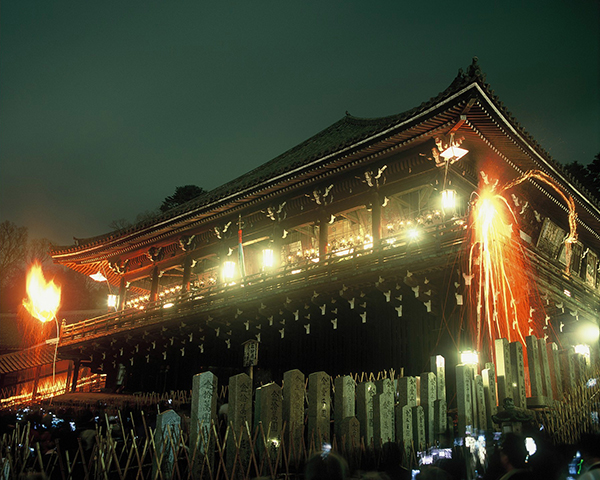The Shuni-e Ceremony

The Shuni-e Ceremony at the Nigatsu-dō is best known by the name of Omizutori. Begun in 752 by Jitchū, the chief disciple of Rōben who founded Tōdai-ji, the ceremony is formally a rite of repentance to Eleven-headed Kannon in which penitence for one’s misdeeds is sought in front of an image of Eleven-headed Kannon. Due to the Three Poisons–covetousness, anger and ignorance that are the true nature of humans–we commit myriad offenses which accumulate as contaminants of the spirit; as a result we become unable to see the truth and we also become ill. Through the ceremony one can repent one’s misdeeds and attain a pure mind and body, do away with the misfortune and woes that are the retribution for one’s evil deeds, and obtain well-being. However, although the Shuni-e is a rite of repentance it is important to remember that when it was begun it was a ritual performed on behalf of the state. Natural disasters, epidemics and rebellions were all seen as “illnesses” of the state and the ritual was performed in order to cure such illnesses, to gain a fruitful harvest of the Five Crops, and to achieve peace under heaven, in other words to guarantee the welfare of the people.
When the rite of repentance is for the state or all its people, a special group of performers and a ceremony of a suitable scale become necessary. Thus, rites of repentance as services to be held by a large number of monks were devised and the Shuni-e Ceremony took form as one such ritual. The monks who participate in it are called the Rengyōshū; presently their number is eleven, among whom various responsibilities are divided. The four senior positions include the Wajō, who administers the Buddhist precepts to the entire group, the Daidōshi, who chants the prayers and the essence of various texts and who functions as the leader of the whole ceremony, the Shushi, who determines the sacred boundaries of the ritual space and who intones the daranis (secret incantations) while forming mudrās (symbolic gestures) with his hands, and the Dōtsukasa, who ensures that the ceremony proceeds properly and is in charge of miscellaneous affairs surrounding the Shuni-e. The remaining seven participants are known as the Hirashū. In addition, there are a number of people who assist the Rengyōshū, so in all almost thirty individuals are directly involved with this ceremony.
The Rengyōshū repent misdeeds on behalf of all people and seek their welfare by praying to Kannon. Since they function in many ways as intermediaries between Kannon and ordinary people, they must possess a considerable amount of religious insight.
On the afternoon of February 28th when the Bekka ends the Ren-gyōshū move to the Shelter of Reclusion located below the Nigatsu-dō, where they reside for the duration of the ceremony. Late that evening the main ceremony begins. Lasting two weeks it is divided into the Former Seven Days and the Latter Seven Days. In turn, each day of the ceremony is divided into six periods: Noon Watch, Sunset Watch, First Evening Watch, Mid-evening Watch, Latter Evening Watch, and Dawn Watch which are known as the Observances of the Six Hours (Rokuji no gyōbō). Because the sutras chanted at each time vary according to their length and speed, throughout the day the shōmyō is exceedingly varied. In many ways this recitation should be seen as a type of Buddhist music.
During the First Evening Watch the Register of the Names of the Kami (Jinmyō-chō) is presented and read, a practice of great antiquity. When Jitchū first held the Observances of the Six Hours at the presentation and recitation of the names of the kami, he summoned the myriad Shinto deities throughout the land and they rushed to the Nigatsu-dō to pray for the success of the ceremony and to provide it with protection. Only the god O-nyū Myōjin of Wakasa was late because he had been fishing. It is said that when he finally did arrive just as the observance was ending, he was so moved that he promised that he would provide lustral water to apologize for his tardiness. Thereupon two comorants, one white and one black, shattered a great boulder and water gushed out of the ground. From that time onward sacred water has flowed plentifully from the spring. After midnight on the twelfth day of the ceremony this sacred water was drawn and offered to Kannon, and it is from this practice that the name Omizutori, literally “the drawing of water,” is derived.
Other parts of the ceremony include the hashiri, when the Ren-gyōshū tuck up their robes and running circumambulate the inner sanctum; the fire ritual known as the dattan, in which a great pine torch is swung about in the inner sanctum; and the presentation and recitation of the Register of the Names of the Dead, including that of the legendary Lady in Blue who is said to have appeared during the ceremony in the Kamakura period inquiring as to why her name was not included in the list. It has been from that time onward. During the two weeks such magnificent practices occur in succession, taking those who attend back to a world of over 1250 years ago.

